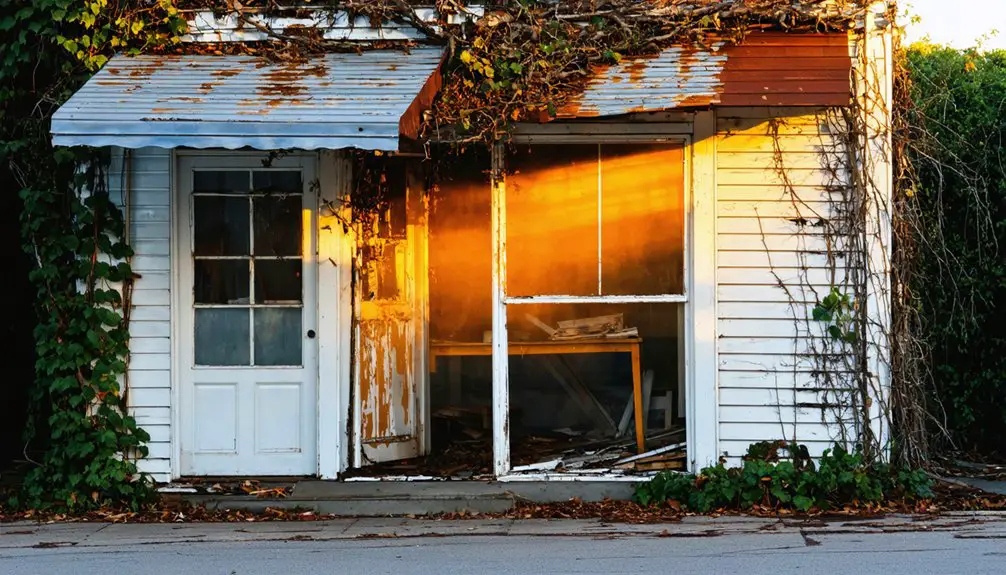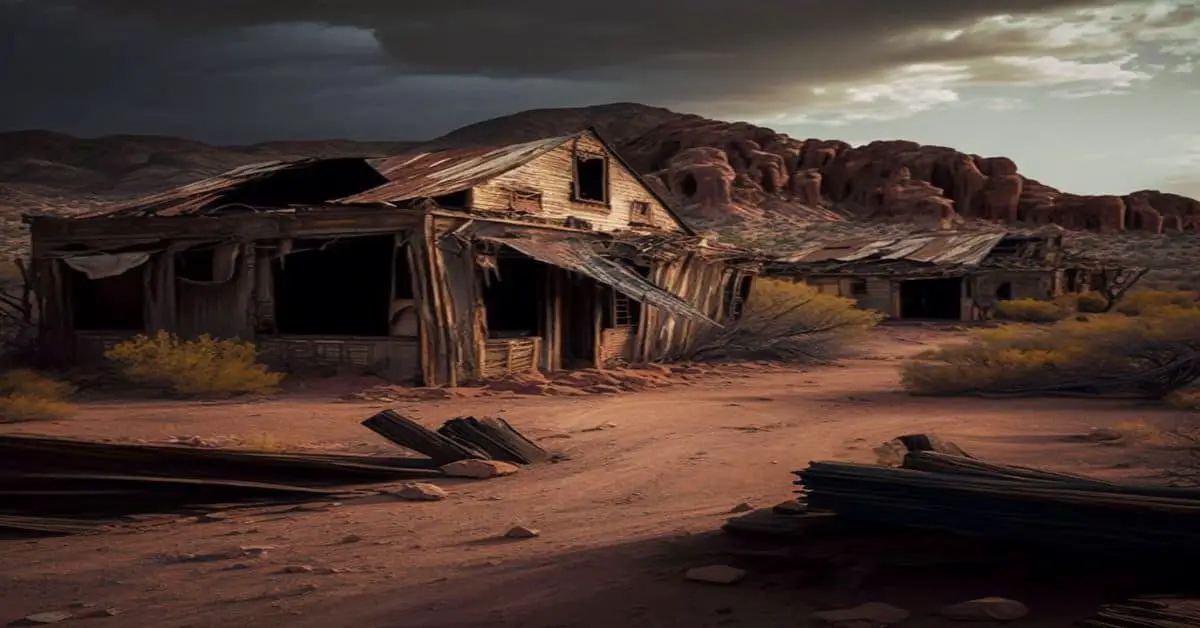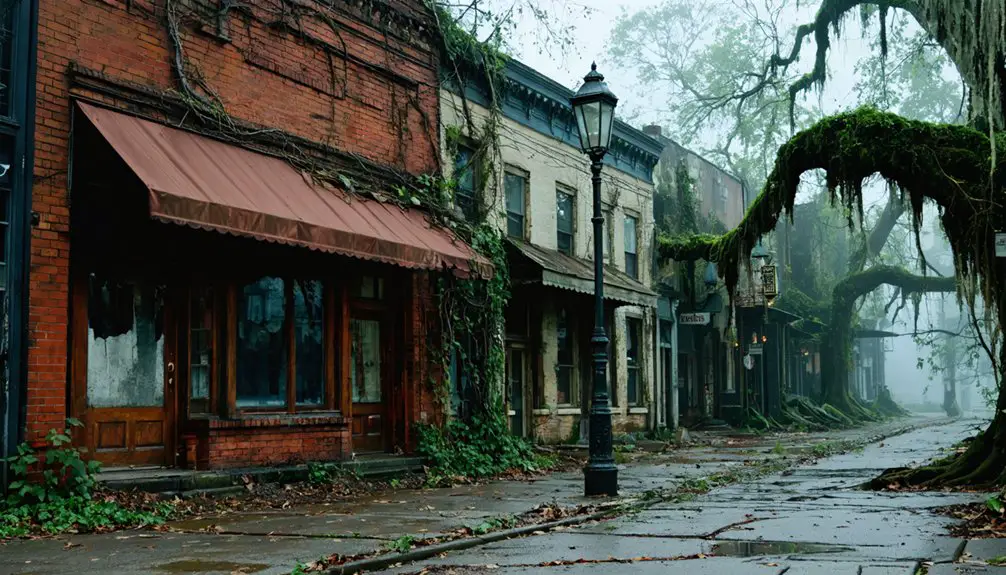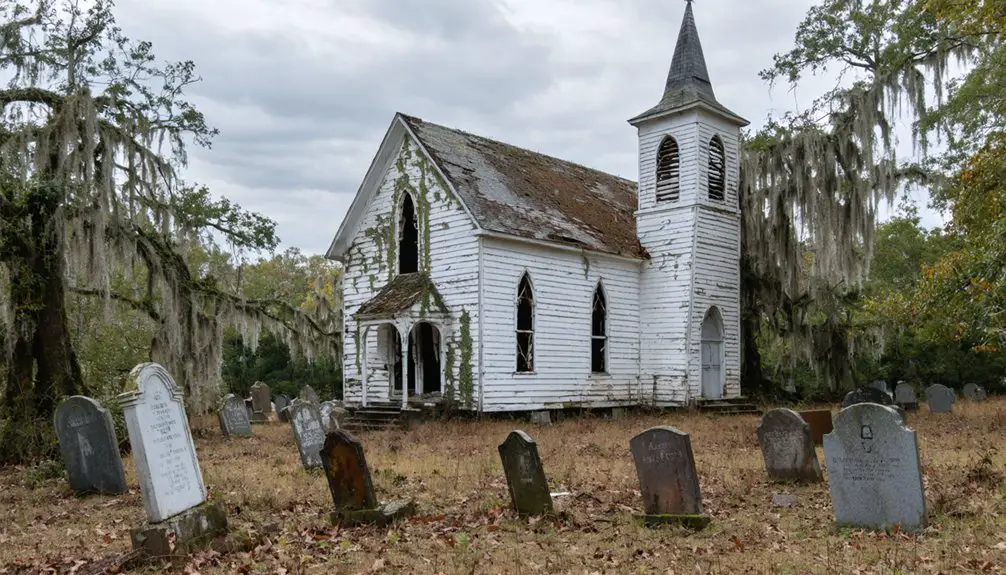You’ll find Hawthorne’s ghost town remnants in South Carolina, where a once-prosperous plantation community vanished in the 1950s. The U.S. government displaced nearly 6,000 residents to build the Savannah River Plant, a nuclear materials facility. Originally established by Callie S. Braswell in 1853, the area featured distinguished antebellum architecture and thriving agricultural operations. Today, only scattered traces mark where this vibrant community stood, its rich history waiting to be uncovered.
Key Takeaways
- Hawthorne was a thriving plantation community in South Carolina that became a ghost town after the 1950s Savannah River Plant Project.
- The displacement of approximately 6,000 residents occurred when the federal government acquired land for nuclear facilities.
- Only scattered physical remnants and faint outlines of streets remain from the once-prosperous farming community.
- The community’s transformation from agricultural land to restricted federal facility happened rapidly, destroying established social networks.
- Historical preservation efforts, including documentaries and archival records, maintain the memory of Hawthorne’s lost community.
Origins of the Braswell Family Estate
In the heart of South Carolina, Callie S. Braswell began shaping his legacy in the 1840s by strategically acquiring land that would establish one of the region’s most notable estates.
Your journey through the Braswell genealogy reveals how he purchased the coveted Hawthorne home site in 1853, just before marrying Martha Ann Trevathan in 1855. Together, they built what would become one of four distinguished antebellum plantations in the Upper Town Creek Rural Historic District.
The estate’s management reflected the complex social structures of the time, as evidenced by the 1847 petition concerning the division of enslaved people among Benjamin Braswell’s heirs. The family’s agricultural expertise would later lead to becoming a fourth-generation company focused on egg production.
While the Hawthorne estate no longer stands today, its foundation marked the beginning of a lasting agricultural dynasty that would transform the region’s landscape. The plantation’s recognition in the National Register listing underscored its historical and architectural significance.
Life in Antebellum Hawthorne
You’ll find that Hawthorne’s plantation house served as both a commanding residence and the administrative center for overseeing agricultural operations, with its architecture reflecting the social hierarchy of the antebellum South.
The main structure was surrounded by essential auxiliary buildings, including detached kitchens and offices, which created a functional compound that reinforced the era’s strict social segregation.
The property was initially acquired by Salters in 1806 as 1,150 acres purchased from the Frierson Family.
Within this carefully ordered environment, daily life revolved around a complex interplay between the privileged planter family managing the estate and the enslaved workers who sustained the plantation’s cotton-based economy.
Plantation House Architecture
While many antebellum Southern plantations boasted grand Greek Revival or Italianate architecture, the Hawthorne plantation house began as a modest log cabin that evolved through practical frontier construction.
The original structure measured 18 by 25 feet, featuring two rooms and a sleeping loft with 18-foot ceilings. You’ll find evidence of plantation craftsmanship in the later addition of an 18 by 33-foot frame section from the Furman Institute barracks, which included two rooms and a garret with its own fireplace. A broad, high-ceilinged hallway ran through the center of the frame addition, providing essential ventilation during hot summers. The building’s construction history revealed small window holes under the eaves from its earliest period.
Both sections were connected by interior doorways between their attic spaces, and steep staircases maximized living areas. The property also featured brick dependencies, including a slave cabin, reflecting the mix of timber and brick materials common in frontier architecture of early South Carolina plantations.
Daily Plantation Social Life
Life within Hawthorne’s plantation walls extended far beyond its architectural features to reveal a strictly hierarchical social order. You’d find white plantation owners and their families at the top, maintaining strict control over the enslaved people’s daily routines through surveillance and segregation.
The enslaved community’s social gatherings centered around shared meals of basic rations – cornmeal, pickled pork, and vegetables – while the white owners enjoyed varied, luxurious fare. The kitchen staff, like enslaved cook Jane Bynes, prepared elaborate meals for the Hammond family while maintaining distinctly separate food preparation for the enslaved community.
You’d see enslaved families working to preserve their bonds despite constant threats of separation through sale. Their living quarters, built from simple materials like stick-and-vine wattle with clay plaster, clustered together but remained deliberately distanced from the main house.
After emancipation, many formerly enslaved families stayed nearby as laborers, evidence of both enduring community ties and persistent structural inequalities.
The Architecture of Hawthorne Plantation
As generations of South Carolina settlers adapted to frontier life, Hawthorne Plantation evolved from a modest log cabin into a unique architectural representation of the region’s development.
You’ll find this historical structure showcases plantation architecture through its organic growth, combining an early 1770s log house with later additions from Furman Institute’s dormitory barracks. The impressive design features one of the earliest giant porticos seen in American residential architecture. Built atop a raised brick foundation, the structure exemplifies the grand architectural elements favored by wealthy plantation owners.
What makes Hawthorne’s historical adaptations fascinating:
- The original frontier cabin transformed into a complex dwelling with interconnected lofts
- You can trace building evolution through mixed materials – log construction meets frame additions
- Specialized features like steep staircases show remarkable adaptation to local needs
- Brick dependencies, including smokehouses and slave cabins, reveal the plantation’s self-sufficient nature
The plantation’s distinctive blend of frontier and institutional architecture stands as a symbol of South Carolina’s resourceful settlers.
African American Heritage and Social Dynamics
Following emancipation at Hawthorne, you’ll find that many formerly enslaved families shifted into sharecropping arrangements, where they worked the same plantation lands but now as contracted laborers rather than enslaved people.
During the 1930s, CCC workers from segregated African American companies helped construct several of South Carolina’s state parks despite facing ongoing discrimination. While African American communities established strong social bonds through churches and mutual aid networks, their economic autonomy remained severely limited by discriminatory policies that restricted land ownership and access to credit. The persistence of inequality reflected the legacy of the pre-war era when black majority populations dominated South Carolina’s demographics until the twentieth century.
The Great Migration ultimately dispersed many African American families from Hawthorne as they sought better opportunities in northern cities, fundamentally altering the plantation’s social fabric and labor system.
During the post-Civil War era, sharecropping emerged as a complex system of agricultural labor in Hawthorne that perpetuated economic inequality and racial hierarchies.
You’ll find that sharecropping challenges faced by African Americans included predatory lending practices and restrictive contracts that made escaping debt nearly impossible.
Despite these systemic barriers, some determined individuals in Hawthorne pursued land acquisition struggles with remarkable resilience:
- They navigated the crop lien system while saving every penny possible
- They sought opportunities through the South Carolina Land Commission
- They built informal networks to share resources and information
- They leveraged tenancy as a stepping stone toward property ownership
These efforts for economic independence occurred against a backdrop of social control mechanisms, including limitations on gatherings and mobility that aimed to maintain plantation dominance in the region.
Community Life After Emancipation
While emancipation brought newfound freedom to Hawthorne’s African American residents, they faced a complex web of social challenges and opportunities in building their post-war community.
You’ll find that churches and mutual aid societies became essential centers of community resilience, providing social support networks and leadership development.
Though Black Codes and vagrancy laws attempted to control their movement and labor, African Americans established strong cultural identities through their religious practices, oral traditions, and collective organizing.
You can see how their determination manifested in various forms of resistance – from maintaining distinct cultural practices to creating autonomous institutions.
Despite violent suppression attempts like the Hamburg Massacre and the rise of Jim Crow laws, tight-knit black communities preserved their heritage through music, storytelling, and spiritual gatherings.
Displacement Impact on Families
As generations of African American families in Hawthorne confronted systemic displacement, their deeply-rooted Lowcountry communities faced unprecedented fragmentation.
The displacement narratives reveal how racial violence, discriminatory laws, and economic exploitation systematically undermined family stability in the post-Reconstruction era.
Despite these pressures, you’ll find remarkable examples of family resilience through:
- Maintaining strong kinship networks that preserved cultural traditions
- Leveraging church communities as anchors of social support
- Developing informal economic networks to resist financial dependency
- Creating communication systems to keep displaced relatives connected
The harsh realities of forced relocation, from the Hamburg Massacre to the Great Migration, transformed family structures.
Yet African American households adapted, finding innovative ways to maintain bonds even as systemic oppression scattered their communities across the region.
The Savannah River Plant Project Impact
The construction of the Savannah River Plant in the 1950s fundamentally transformed South Carolina’s landscape and regional demographics, leading to the displacement of 6,000 residents across six communities, including Hawthorne.
In 1950s South Carolina, thousands lost their homes as the Savannah River Plant reshaped both land and lives forever.
You’ll find this massive 310-square-mile facility wasn’t just any industrial project – it became a cornerstone of America’s nuclear program, producing 36.1 metric tons of weapons-grade plutonium over three decades.
The plant’s development dramatically altered the region’s character, with surrounding towns like Williston becoming relocation centers for displaced residents.
Beyond its military significance, the facility brought unprecedented changes to local governance and land use.
Today, the site continues to shape the region through its nuclear waste management programs and environmental management initiatives, though you’ll never see the original communities that once called this land home.
Community Displacement and Relocation
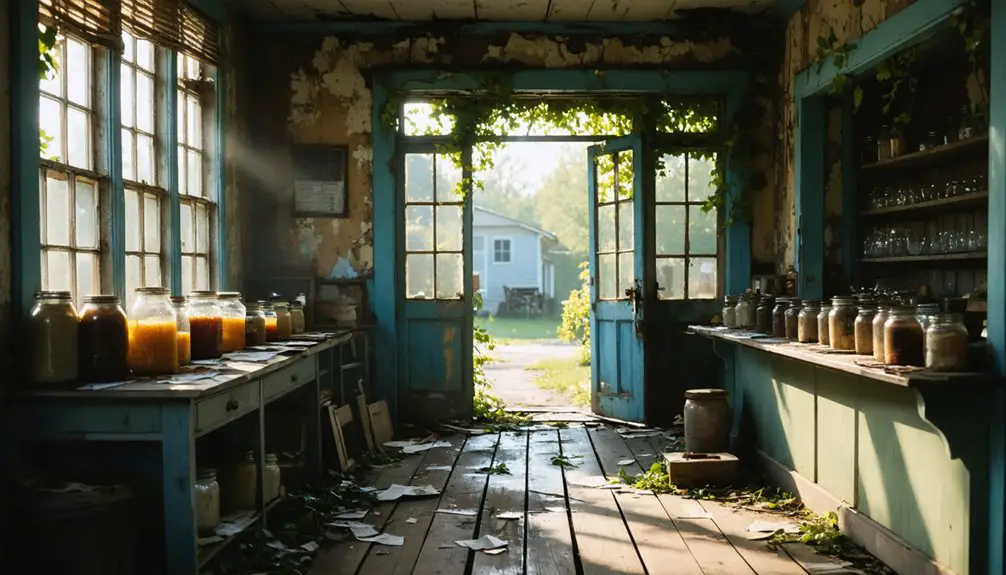
You’ll find that the government’s acquisition of land for the Savannah River Plant forced approximately 6,000 residents out of their homes, with African-American farmers and sharecroppers being disproportionately affected.
The mandatory relocation scattered families across new settlements like New Ellenton, Jackson, and Beech Island, while some residents moved their physical homes to different locations.
As communities dispersed, long-established social networks fractured, and residents lost cherished institutions like churches and schools that had been central to their way of life.
Government Acquisition Impact
When President Truman’s administration initiated the Savannah River Plant project in 1950, approximately 6,000 residents found themselves forcibly displaced from their homes across three South Carolina counties. The government’s economic valuation severely undervalued the land, offering only $19 million for property worth substantially more, including $28 million in lumber alone.
The impact on community resilience was devastating:
- Families had to physically relocate their own homes without government assistance.
- Long-established social networks and economic systems were shattered overnight.
- Residents scattered to various locations including New Ellenton, Jackson, and Augusta.
- Many were forced to abandon their traditional farming and sharecropping livelihoods.
This massive displacement permanently altered the cultural and economic fabric of these rural communities, leaving only silent foundations where vibrant towns once stood.
Families Forced to Move
Following government acquisition orders in 1950, thousands of Hawthorne families faced devastating personal and economic upheaval as they were forced to abandon their homes, farms, and multi-generational properties.
You’d witness entire families uprooted from their ancestral lands, including historic plantations like the Braswell residence, often without adequate compensation.
The displacement led to severe economic hardship as agricultural livelihoods and local businesses crumbled. Families couldn’t transfer their farming skills to new locations, while the loss of railroad stops and commerce hubs further diminished job prospects.
This forced migration triggered profound cultural erosion as community bonds fractured and traditional practices tied to the land disappeared.
Children’s education suffered from school closures, while elderly residents struggled to adapt, permanently altering the region’s demographic makeup.
Community Bonds Disrupted
The forced relocation shattered more than just physical homes – it devastated the intricate social fabric that had defined Hawthorne for generations.
Despite remarkable community resilience, the displacement created deep social fragmentation as tight-knit farming families were scattered across South Carolina and beyond.
The human cost of this disruption manifested in several profound ways:
- Long-established churches, schools, and gathering places were destroyed, eliminating essential spaces where neighbors once connected.
- Extended families who’d supported each other for generations found themselves separated by distance.
- Traditional mutual aid networks among sharecroppers and farmers collapsed.
- Residents struggled to rebuild their sense of belonging in unfamiliar towns like New Ellenton, where they lacked their former support systems.
Agricultural Legacy and Economic Transformation
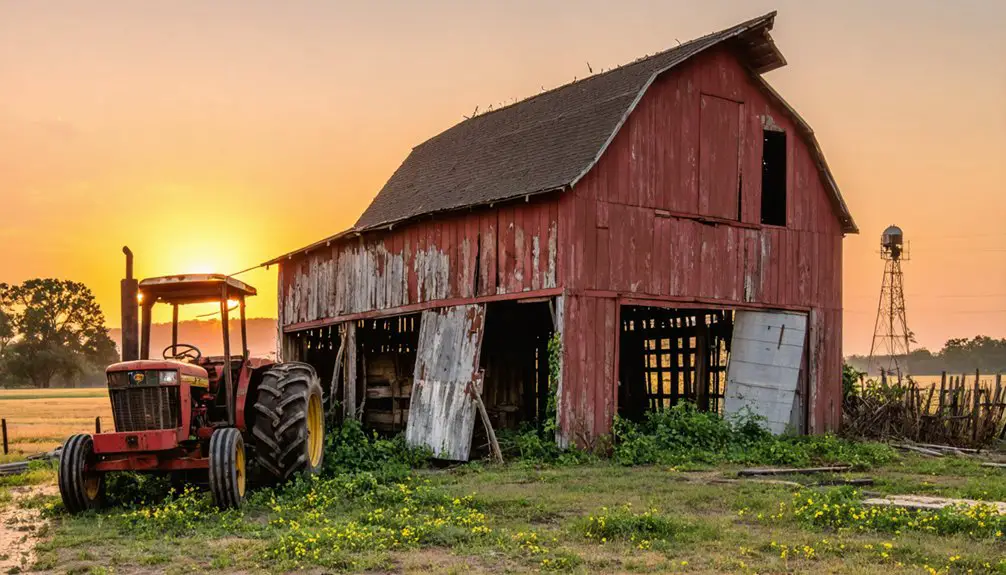
Established along essential trading routes in the late 18th century, Hawthorne’s agricultural foundation shaped its economic identity through successive generations of farmers and plantation owners.
You’d have witnessed the town’s resilience through evolving agricultural practices, from Sea Island cotton production to diverse crop cultivation after the devastating 1894 Great Freeze and boll weevil infestations.
The intersection of two rail lines transformed Hawthorne into a crucial agricultural hub, while the paving of Highway 20 enhanced farm-to-market access.
Despite economic challenges like the Great Depression, the community’s economic resilience shone through as it adapted with turpentine production, brickmaking, and expanded farming operations.
Historic estates like the Ashford-Hawthorne house still stand as evidence to the plantation era that defined the region’s early development.
Preserving Hawthorne’s Historical Records
While Hawthorne’s physical structures and agricultural legacy faced decline, dedicated preservation efforts emerged to safeguard its historical narrative. Through historical documentation initiatives and archival access programs, you’ll find multiple organizations working to preserve Hawthorne’s story for future generations.
- The Savannah River Archaeological Research Program’s collaboration with filmmaker Patrick Hayes produced “Reconstructing Hawthorne,” a documentary that captures the community’s final residents through powerful interviews.
- South Carolina’s Department of Archives and History maintains over 325 years of essential records.
- The State Historic Preservation Office provides significant protection for historical sites.
- Preservation South Carolina actively supports the conservation of rural communities and cultural landmarks.
These coordinated efforts guarantee that while Hawthorne’s physical presence may have faded, its historical significance endures through careful preservation and documentation.
The Upper Town Creek Rural Historic District
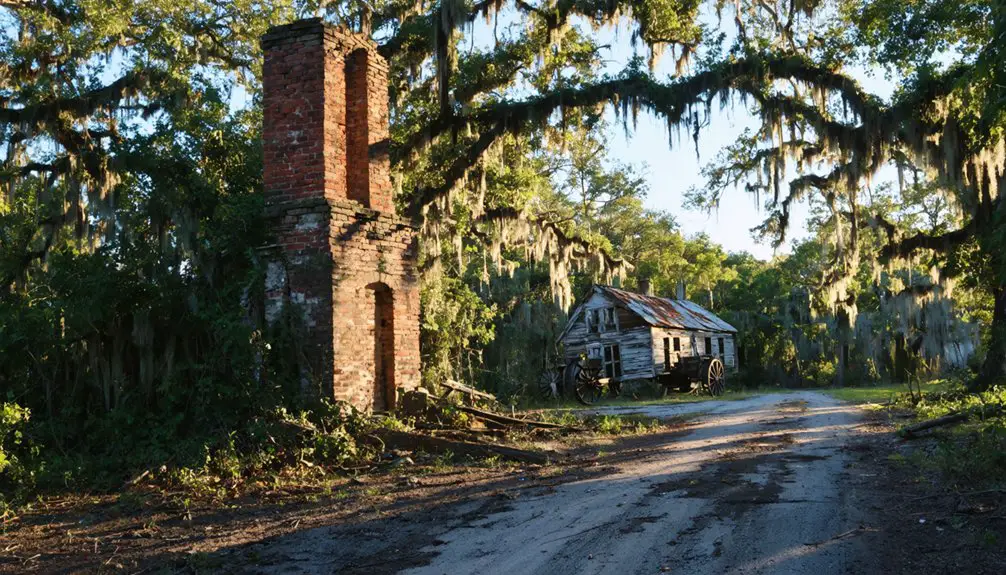
Located near Wilson in eastern North Carolina, the Upper Town Creek Rural Historic District encompasses four contiguous farms that showcase the region’s antebellum agricultural heritage.
The district’s 117 contributing buildings represent the architectural evolution of plantation life, featuring Federal, Greek Revival, and Gothic Revival styles.
While none of the four principal plantation houses remain standing today, the Braswell legacy lives on through historical documentation of their “Hawthorne” estate, built circa 1855.
You’ll find the district’s historic preservation efforts reflected in its surviving agricultural outbuildings, including tobacco barns, packhouses, and tenant houses.
Though distinct from South Carolina’s Hawthorne ghost town, this district serves as a reflection of the wealthy planter class that shaped North Carolina’s agricultural landscape during the mid-1800s.
Modern Day Remnants and Historical Significance
Today, you’ll find few physical traces of Hawthorne’s once-thriving community, with only scattered remnants of paved streets, curbs, driveways, and walkways marking its former existence.
Time has erased Hawthorne’s vibrant past, leaving only faint outlines of streets and walkways as silent witnesses.
Like many ghost towns created by federal land acquisition, Hawthorne’s story reflects a broader pattern of displacement during the Cold War era.
Historical preservation efforts have documented these significant changes through:
- Oral histories from displaced residents who witnessed their community’s dissolution
- Genealogical records tracing the diaspora of approximately 6,000 people
- Archaeological remnants revealing the agricultural heritage of antebellum plantations
- Documented patterns of migration as families relocated to new communities
The land’s transformation from a rural farming community to a restricted federal facility stands as a symbol of how quickly established communities can disappear, leaving only fragments of their existence behind.
Frequently Asked Questions
Are There Any Ghost Stories or Supernatural Legends Associated With Hawthorne?
You won’t find documented ghost sightings or local folklore about Hawthorne in historical records. While the town’s forced abandonment was dramatic, no supernatural legends have been officially reported or preserved.
What Happened to the Displaced Residents’ Personal Belongings and Graves?
Like leaves scattered by wind, displaced belongings were mostly self-moved by residents. You’ll find they transported what they could, while government workers relocated about 6,000 graves to nearby communities.
Did Any Original Hawthorne Buildings Survive Relocation to Other Towns?
You won’t find any original structures from Hawthorne standing today – no historical preservation efforts successfully relocated the buildings, and by 2020, all antebellum plantation structures had completely disappeared from existence.
What Wildlife Now Inhabits the Abandoned Hawthorne Town Site?
In the blink of an eye, you’ll spot white-tailed deer, coyotes, bobcats, and various bird species thriving there. Environmental changes have transformed the site into a haven for native wildlife.
Were There Any Notable Crimes or Conflicts in Hawthorne Before Abandonment?
You won’t find documented crime history or major conflict events in the historical records, though there were legal disputes over slave ownership and some post-Civil War social tensions among families.
References
- https://afamwilsonnc.com/2023/09/23/the-callie-s-braswell-house-known-as-hawthorne/
- https://nvtami.com/2023/07/04/hawthorne-ghost-town-trip/
- https://www.geotab.com/ghost-towns/
- https://www.wikiwand.com/en/articles/List_of_ghost_towns_in_South_Carolina
- https://en.wikipedia.org/wiki/Ellenton
- https://ncfieldfamily.org/farm/braswell-family-farms-takes-historic-ties-into-its-future/
- http://braswellgenealogy.blogspot.com/2010/09/
- https://dekalbhistory.org/wp-content/uploads/2020/04/dekalb-history-center-braswell.pdf
- https://www.familysearch.org/library/books/records/print?search=braswell&sort=_score&perpage=10&page=1
- https://theforgottensouth.com/salters-depot/
